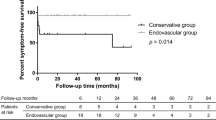Abstract
Purpose
To analyze factors potentially associated with the occurrence of distal edge stenosis after stent placement for isolated superior mesenteric artery dissection (ISMAD).
Materials and Methods
Cases of consecutive patients who were diagnosed with spontaneous ISMAD between February 2010 and July 2018 were retrospectively identified. Of the 123 cases identified, 45 patients (42 men; three women) underwent endovascular stent placement and were included in the study. Univariate and multivariate analyses were used to assess factors potentially associated with distal edge stenosis.
Results
The technical success rate among study patients was 100%. During 26.7 ± 17.3 months of follow-up, CT angiography demonstrated good distal edge patency in 25 patients (55.6%) and evidence of distal edge stenosis in 20 patients (44.4%). In univariate analysis, stent length (odds radio [OR] 1.03; 95% confidence interval [CI] 1.01, 1.06; P = .02), stent-to-vessel (S/V) diameter ratio (OR 2.27; 95% CI 1.35, 3.82; P < .01), and angulation at the distal edge (OR 1.05; 95% CI 1.00, 1.10; P =.03) were significantly associated with distal edge stenosis; only S/V diameter ratio (OR 3.36; 95% CI 1.41, 7.99; P < .01) and angulation at the distal edge (OR 1.12; 95% CI 1.01, 1.23; P =.03) retained this significance in multivariate analysis.
Conclusions
Distal edge stenosis after stent placement for ISMAD is common. S/V diameter ratio and angulation at the distal edge are independent risk factors for distal edge stenosis in patients with ISMAD who undergo stent placement.


Similar content being viewed by others

References
Bjorck M, Koelemay M, Acosta S, et al. Editor’s choice—management of the diseases of mesenteric arteries and veins: clinical practice guidelines of the European Society of Vascular Surgery (ESVS). Eur J Vasc Endovasc Surg. 2017;53:460–510.
Jia ZZ, Zhao JW, Tian F, et al. Initial and middle-term results of treatment for symptomatic spontaneous isolated dissection of superior mesenteric artery. Eur J Vasc Endovasc Surg. 2013;45:502–8.
Kim J, Yoon CJ, Seong N, et al. Spontaneous dissection of superior mesenteric artery: long-term outcome of stent placement. J Vasc Interv Radiol. 2017;28:1722–6.
Li N, Lu QS, Zhou J, et al. Endovascular stent placement for treatment of spontaneous isolated dissection of the superior mesenteric artery. Ann Vasc Surg. 2014;28:445–51.
Dong Z, Fu W, Chen B, et al. Treatment of symptomatic isolated dissection of superior mesenteric artery. J Vasc Surg. 2013;57:69S–76S.
Lin TC, Huang CY, Chen PL, et al. Edge stenosis after covered stenting for long superficial femoral artery occlusive disease: risk factor analysis and prevention with drug-coated balloon angioplasty. J Endovasc Ther. 2018;25:313–9.
Al-Hakim R, Lee EW, Kee ST, et al. Hemodynamic analysis of edge stenosis in peripheral artery stent grafts. Diagn Interv Imaging. 2017;98:729–35.
Kang WC, Park YM, Shin KC, et al. Predictors of edge stenosis after paclitaxel-eluting stent implantation. Coron Artery Dis. 2011;22:59–63.
Sakurai R, Ako J, Morino Y, et al. Predictors of edge stenosis following sirolimus-eluting stent deployment (a quantitative intravascular ultrasound analysis from the SIRIUS trial). Am J Cardiol. 2005;96:1251–3.
Ino Y, Kubo T, Kitabata H, et al. Impact of hinge motion on in-stent restenosis after sirolimus-eluting stent implantation. Circ J. 2011;75:1878–84.
Kurata N, Iida O, Shiraki T, et al. Impact of stent-to-vessel diameter ratio on restenosis in the superficial femoral artery after endovascular therapy. Circ J. 2018;82:1412–7.
Carter AJ, Laird JR, Farb A, et al. Morphologic characteristics of lesion formation and time course of smooth muscle cell proliferation in a porcine proliferative restenosis model. J Am Coll Cardiol. 1994;24:1398–405.
Zhao HQ, Nikanorov A, Virmani R, et al. Late stent expansion and neointimal proliferation of oversized Nitinol stents in peripheral arteries. Cardiovasc Intervent Radiol. 2009;32:720–6.
Kornowski R, Hong MK, Tio FO, et al. In-stent restenosis: contributions of inflammatory responses and artery injury to neointimal hyperplasia. J Am Coll Cardiol. 1998;31:224–30.
Chen HY, Moussa ID, Davidson C, et al. Impact of main branch stenting on endothelial shear stress: role of side branch diameter, angle and lesion. J R Soc Interface. 2012;9:1187–93.
Kim YG, Oh IY, Kwon YW, et al. Mechanism of edge restenosis after drug-eluting stent implantation. Circ J. 2013;77:2928–35.
Acknowledgements
We thank Jian Wang, Qiao Chen and Weixing Zhuang, for their help with data analysis; and Megan Griffiths, scientific writer, Cleveland, Ohio, USA, for her help with revising the manuscript.
Funding
This study was supported by the China Postdoctoral Science Foundation (2018M630582), the Natural Science Foundation of China (81401498), and the Jiangsu Provincial Medical Youth Talent (QNRC2016270). The funders had no role in study design, data collection and analysis, decision to publish, or preparation of the manuscript.
Author information
Authors and Affiliations
Corresponding authors
Ethics declarations
Conflict of interest
The authors indicated no potential conflicts of interest.
Additional information
Publisher's Note
Springer Nature remains neutral with regard to jurisdictional claims in published maps and institutional affiliations.
Rights and permissions
About this article
Cite this article
Hang, C., Chen, W., Su, H. et al. Distal Edge Stenosis After Stent Placement for Isolated Superior Mesenteric Artery Dissection: Mechanisms and Risk Factor Analysis. Cardiovasc Intervent Radiol 42, 1095–1101 (2019). https://doi.org/10.1007/s00270-019-02244-3
Received:
Accepted:
Published:
Issue Date:
DOI: https://doi.org/10.1007/s00270-019-02244-3



